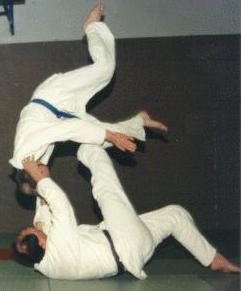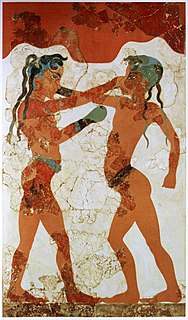
Grappling, in hand-to-hand combat, is the act of gripping or seizing the opponent, as in wrestling. Grappling is used at close range to gain a physical advantage such as improving relative position, or to cause injury to the opponent. Grappling covers techniques used in many disciplines, styles and martial arts that are practiced both as combat sports and for self-defense. Grappling contests often involve takedowns and ground control, and may end when a contestant concedes defeat, also known as a submission or tap out.

A kick is a physical strike using the leg, in unison usually with an area of the knee or lower using the foot, heel, tibia, ball of the foot, blade of the foot, toes or knee. This type of attack is used frequently by hooved animals as well as humans in the context of stand-up fighting. Kicks play a significant role in many forms of martial arts, such as savate, taekwondo, MMA, sikaran, karate, Pankration, Kung Fu, Vovinam, kickboxing, Muay Thai, Yaw-Yan, capoeira, silat, and kalaripayattu. If the kick is to a target, it is a form of compliance

Pankration was a sporting event introduced into the Greek Olympic Games in 648 BC and was an empty-hand submission sport with scarcely any rules. The athletes used boxing and wrestling techniques, but also others, such as kicking and holds, locks and chokes on the ground. The only things not acceptable were biting and gouging out the opponent's eyes.
Professional wrestling throws are the application of professional wrestling techniques that involve lifting the opponent up and throwing or slamming them down. They are sometimes also called "power" maneuvers, as they are meant to emphasize a wrestler's strength. Many of these moves are used as finishers by many wrestlers. Many maneuvers are known by several different names. Professional wrestlers frequently give their "finisher" new names that reflect their gimmick. Moves are listed under general categories whenever possible.

A strike is a directed physical attack with either a part of the human body or with an inanimate object intended to cause blunt trauma or penetrating trauma upon an opponent.
Attacking maneuvers are offensive moves in professional wrestling, used to set up an opponent for a submission hold or for a throw. There are a wide variety of attacking moves in pro wrestling, and many are known by several different names. Professional wrestlers frequently give their finishers new names. Occasionally, these names become popular and are used regardless of the wrestler performing the technique.

Shadowboxing is an exercise used in the training for combat sports, especially, as its name implies, in boxing. It is used mainly to prepare the muscles before the person training engages in stronger physical activity. In shadowboxing, only one person is required to participate; the participant throws punches at no one in particular. Muhammad Ali once performed a now famous shadowboxing routine next to Howard Cosell for ABC's Wide World of Sports television cameras.

The Boston crab is a professional wrestling hold that typically starts with one wrestler lying in a supine position on the mat, with the other wrestler standing and facing him. It is a type of spinal lock where the wrestler hooks each of the opponent’s legs in one of his arms and then turns the opponent face-down, stepping over him in the process. The final position has the wrestler in a semi-sitting position and facing away from his opponent, with the opponent’s back and legs bent back toward his head. The original name for the maneuver was the Backbreaker, before that term became known for its current usage. In modern wrestling, the Boston crab is not treated as a lethal submission maneuver, even though it was considered a match-ending hold in the past.

The mount, or mounted position, is a dominant ground grappling position, where one combatant sits on the other combatants torso with the face pointing towards the opponent's head. This is a favorable position for the top combatant in several ways. The top combatant can generate considerable momentum for strikes to the head of the opponent, while the bottom combatant is restricted by the ground and by the combatant on top. Other advantages include various chokeholds and joint locks that can be applied from the top. The bottom combatant will usually look to sweep the opponent or transition into a better position such as the guard.

A leglock is a joint lock that is directed at joints of the leg such as the ankle, knee or hip joint. A leglock, which is directed at joints in the foot, is sometimes referred to as a foot lock and a lock at the hip as a hip lock. Leglocks are featured, with various levels of restrictions, in combat sports and martial arts such as Sambo, Brazilian Jiu-Jitsu, catch wrestling, mixed martial arts, Shootwrestling and submission wrestling, but are banned in some sports featuring joint locks such as judo.

A roundhouse kick is a kick in which the practitioner lifts their knee while turning the supporting foot and body in a semicircular motion, extending the leg striking with the lower part of the shin and/or the instep the ball of the foot can also be used to strike the target and is preferable when power breaking thick boards. This type of kick is utilized in many different martial arts and is popular in both non-contact and full-contact martial arts competitions. The kick has many variations based on stance, leg movement, striking surface, and the height of the kick.

A knee strike is a strike with the knee, either with the kneecap or the surrounding area. Kneeing is a disallowed practice in many combat sports, especially to the head of a downed opponent. Styles such as Muay Thai and several mixed martial arts organizations allow kneeing depending on the positioning of the fighters.

Clinch fighting is the part of stand-up fighting where the combatants are grappling in a clinch, typically using clinch holds. Clinching the opponent can be used to eliminate the opponent's effective usage of some kicks, punches, and melee weapons. The clinch can also be used as a medium to switch from stand-up fighting to ground fighting by using takedowns, throws or sweeps.

A grappling hold commonly referred to simply as a hold and in Japanese referred to as katame-waza is a specific grappling, wrestling, judo or other martial arts grip that is applied to an opponent. Holds are principally used to control the opponent, and to advance in points or positioning. Holds may be categorized by their function such as clinching, pinning or submission, while others can be classified by their anatomical effect: chokehold, joint-lock or compression lock.

In martial arts, a throw is a grappling technique that involves off-balancing or lifting an opponent, and throwing them to the ground, in Japanese martial arts referred to as nage-waza, 投げ技, "throwing technique". Throws usually involve a rotating motion, the practitioner performing the throw disconnects with the opponent, and ends balanced and on their feet as opposed to a takedown where both finish on the ground. Throws can however also be followed into a top position, in which case the person executing the throw does not disengage from the opponent. Certain throwing techniques called sacrifice throws involve putting oneself in a potentially disadvantageous position, such as on the ground, in order to execute a throw.

Half guard is a ground grappling position where one combatant is lying on the other, with the bottom combatant having one leg entangled. Sometimes the bottom combatant is said to be in half guard, while the top combatant is in a half mount. In wrestling and catch wrestling half mount is called Turk ride. The half guard is the position that is in between a full guard and side control or full mount. The combatant on top will try to untangle the leg and obtain side control or mount, while the bottom combatant will try to transition into a full guard or alternatively attempt a sweep or submission. The combatant on top is however in a better position, and can strike or attempt submission holds, although not as well as in side control.

Collar-and-elbow wrestling is a style of folk wrestling native to Ireland that can be traced back to the 17th century but it has ties to the Games of Tailtinn between 632 BC and 1169 AD. Though originating in Ireland, the style flourished in America, Australia and Argentina. Collar-and-elbow features an array of trips, mares/throws, hip-locking, shin kicking, pinning combinations, and limited knowledge of submissions.



















